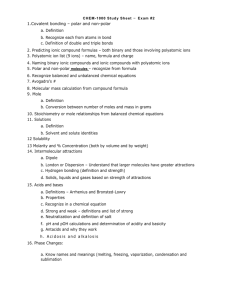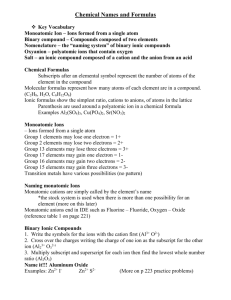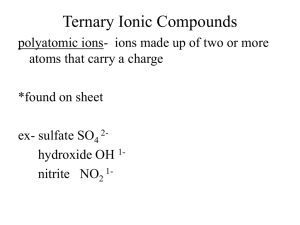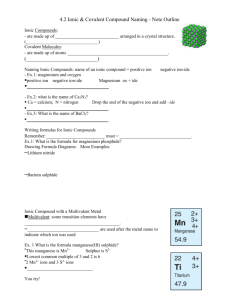Unit 5 - My CCSD
advertisement
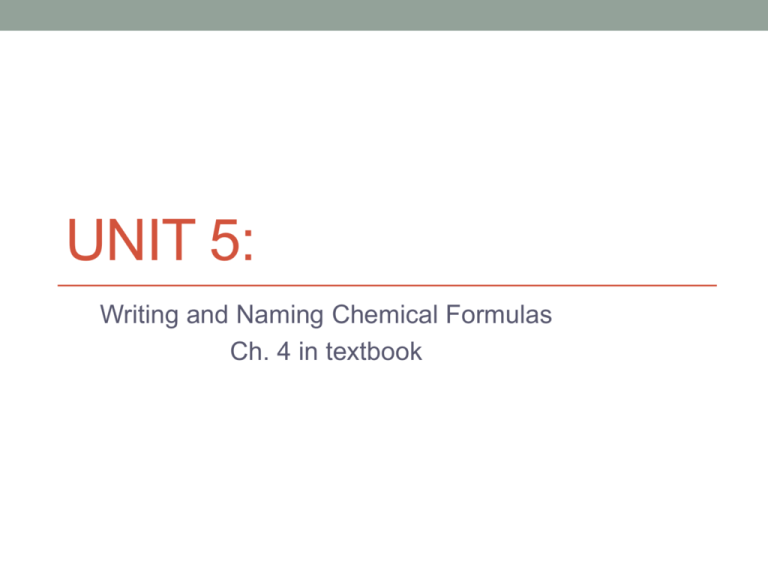
UNIT 5: Writing and Naming Chemical Formulas Ch. 4 in textbook 5.1 Ionic Bonding • When it comes to bonding, ELECTRONS call the shots! It is the arrangement of the valence electrons that will dictate which kind of bond will form. Ionic Bonds and Ionic Compounds: • Remember: an ION is… an atom which has lost or gained electrons and is now CHARGED (+) or (-). • An ionic bond: • a cation (+) and an anion (-)… two oppositely charged ions. The bond itself is electrically neutral (no charge associated) so the amount of charge on the cation and the anion MUST EQUAL! • Anions only bond with cations… like charges will not bond and do not want to be associated with each other. Types of Ions: • You have 2 distinct origins for ions: • 1. Ions created by one atom. • 2. Ions created by 2 or more atoms. • Type #1 ions are called monatomic ions, which can be subdivided into cations and anions. Remember mono is the prefix meaning “one”. • Type #2 ions are called polyatomic ions, poly being the prefix meaning “many”. POLYATOMIC IONS • There are several polyatomic ions, both cationic and anionic. They consist of at least 2 atoms and bond with ions of equal charge. Naming Ionic Compounds • MONATOMIC CATIONS (+): • Positive Ions • Monatomic cations (a single atom with a non-negative charge) take the name of the element plus the word "ion" Examples: • Na+ = sodium ion • Zn 2+ = zinc ion • Forms more than one (1) positive ion? The charge is indicated by the Roman numeral in parentheses followed by the word "ion" Examples: • Fe 2+ = iron (II) ion • Fe 3+ = iron (III) ion * refer to the table on page 231 in your text.* • Negative Ions • Monatomic anions (a single atom with a negative charge) change their ending to "-ide" Examples: •O 2- = oxide • Cl - = chloride Binary Ionic Compounds: • When ions bond they form ionic compounds, of which the simplest type is the binary ionic compound. • This occurs when only 2 elements, or 2 monatomic ions, bond. These compounds are named by First, writing the name of the cation followed by the name of the anion. For example… the ionic compound made of Na and F is called sodium fluoride… the ionic compound made of Zn and O is called zinc oxide. • Unfortunately, these names do not tell you the ratios of the element being bonded. Is it 1:1 or 1:3? This is communicated by the empirical formula. This type of formula uses the chemical symbols for the atoms of the compound, and subscripts to indicate their RATIOS. • When combining cations & anions into an ionic compound, you always put the cation name first & then the anion name (the molecules are also written in that order as well.) • Examples: • Na+ + Cl - --> NaCl sodium + chloride --> sodium chloride + SO4 2- -->CuSO4 copper(II) + sulfate --> copper(II) sulfate • Cu 2+ + NO3- --> Al(NO3)3 aluminum + nitrate --> aluminum nitrate • Al 3+ Practice • Compound CaI2 Mg3P2 LiBr Al2O3 NaCl BN Name 5.2 Hydrates • When an Ionic compound absorbs H2O it is called a HYDRATE. • Hydrated ionic compounds have a specific number of water molecules in their chemical formulas. • In the solid, these water molecules (also called "waters of hydration") are part of the structure of the compound. Naming Hydrates • Rule 1. The ionic compound (without the waters is named first using ionic naming • 1 mono rules. • 2 di • 3 tri • Rule 2. Greek prefixes are attached to • 4 tetra the word "hydrate" to indicate the • 5 penta number of water molecules per formula • 6 hexa unit for the compound. • 7 hepta • • 8 octa Rule 3. When the chemical formula for a • 9 nona hydrated ionic compound is written, the • 10 deca formula for the ionic compound is separated from the waters of hydration by a "dot". of hydration) Practice • CuSO4 . 5 H2O • Copper (II) sulfate pentahydrate • MgSO4 . 9 H2O • Magnesium sulfate nonahydrate • BaCl2 . 2 H2O • barium chloride dihydrate 5.3 Covalent Bonding • “A covalent bond is formed by a shared pair of electrons between two atoms.” Molecules and Their Formulas • When atoms are bonded by a covalent bond they are called a molecule. Theses molecules can contain 2 or more atoms covalently bonded in any arrangement possible. To know the elements and the ratios of those elements in the molecule you will need to know its molecular formula. This formula always tells us the elements, in the molecule, and exactly how many there are being used. • For example: The molecular formula for sucrose (table sugar) is C12H22O11. This means we have 12 carbons, 22 hydrogens and 11 oxygens - exactly! • Another type of formula we can use to describe the molecule is the structural formula. This type of formula illustrates HOW the elements are attached together, or which atoms are bonding. • For example: we all know H2O is water… and this is its molecular formula. However, its structural formula is actually HOH because each hydrogen is bonded to only the oxygen. Covalent Bonding Naming Rules The more positive atom is written first (the atom which is the furthest to the left and to the bottom of the periodic table) • The more negative second atom has an "-ide" ending. • A prefix indicates the number of each atom present in the compound. Covalent Prefixes Number of Atoms 1 2 3 4 5 6 7 8 9 10 Prefix Mono (don’t use on 1st element) Di Tri Tetra Penta Hexa Hepta Octa Nona Deca Practice Formulas CO2 CCl4 P2O5 PBr3 N2 O Name Carbon Dioxide Carbon Tetrachloride Diphosphorous Pentaoxide Phosphorous Tribromide Dinitrogen Monoxide 5.4 Acids Binary acids- acids that are made of only two elements (no Oxygen) • • A. Prefix is always hydro B. Name the second element with the suffix- ic • EX: HCl Hydrochloric acid Ternary acids- those acids that are made of more than two elements; usually contain a polyatomic ion (have Oxygen) • A. For the acid containing the most common polyatomic ion of its group simply use the first part of the polyatomic name and follow with the suffix ic. • B. For the acid containing the polyatomic with one less oxygen than the ic, use the suffix ous. • C. For the acid containing the polyatomic with two less oxygens than the ic, use the prefix hypo and the suffix ous. • D. For an acid containing the polyatomic with one more oxygen than the ic, use the prefix per and the suffix ic. Examples of acid nomenclature • Rule 1: all acids must contain hydrogen • Rule 2: acids with `ic' suffix represent natural `ate' polyatomic ions HBrO3 bromic acid • Rule 3: when all oxygen atoms are removed, add `hydro' prefix to name HBr hydrobromic acid HCl hydrochloric acid • Rule 4: when an extra oxygen is added, `per' prefix to name HBrO4 perbromic acid HClO4 perchloric acid add a • 5: when 1 oxygen is taken away (from `ate' ion number), change the `ic' suffix to `ous' HBrO2 bromous acid HClO2 chlorous acid • Rule 6: when 2 oxygens are taken away (from `ate' ion number), change the `ic' suffix to `ous' and add a `hypo' prefix HBrO hypobromous acid HClO hypochlorous acid
